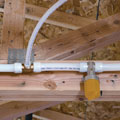
As of
Jan. 1, the 2009 International Residential Code mandates residential fire
sprinklers in all one- and two-family dwellings. Photo courtesy of Uponor
Happy New Year! With the ringing in of Jan. 1, 2011, all of us in the engineering profession have been presented with a dilemma. I should indicate that this dilemma extends to architects, as well. You may be wondering what the concern is.
On Jan. 1, the 2009 ICC International Residential Code mandates residential sprinklers in all one- and two-family dwellings. The IRC had already mandated residential sprinklers in townhouses.
Prior to Jan. 1, the ICC International Building Code required sprinkler protection in all residential buildings. Furthermore, NFPA 5000 has always required all residential buildings to be protected with a residential sprinkler system.
The next edition of the IRC will be the 2012 edition. That is scheduled for publication later this year. The 2012 edition of the IRC also mandates residential sprinklers for all one- and two-family dwellings and townhouses.
As professional engineers, our first obligation is to the public, not our client. We are also required to follow accepted engineering practice. Accepted engineering practice means we have to follow the guidelines produced and developed by our industry. That includes the IRC, IBC and NFPA 5000.
What all this means is that from this day forward if you are involved in the design of systems in any one- or two-family dwelling or townhouse, you need to include a residential sprinkler system. If you do not, you are jeopardizing your engineering license by not upholding your first obligation to protect the public, plus not upholding your obligations to follow accepted engineering practice.
The builder may not follow your plans. He may choose not to install the residential sprinkler system, but that is OK. You did your duty by showing the system on the plans. The liability shifts to the builder if he chooses not to install the residential sprinkler system. I plan to also cover my bases by sending a letter to the builder or developer indicating that sprinklers are required.
Some Disagree
I was speaking to an engineering colleague last week regarding this very issue. He disagrees with me, saying that if the state or local politicians delete the sprinkler requirements from the code, the engineer has no obligation to design the system. There is no denying that the various state home builders’ associations have been spending millions lobbying their politicians to have the requirement removed from the adoption of the 2009 IRC.Just because politicians do something that many of us consider stupid, it does not reduce the liability of professional engineers to do what they are charged to do. In other words, we must protect the public. I cannot fathom how any engineer could declare that residential sprinklers do not protect the public.
Litigation Waiting To Happen
I am sure some, or many, smart attorneys are just waiting in the wings for the first fire death in a home built after Jan. 1, 2011. I hate to say it, but it will unfortunately have to involve a fire death. With around 3,000 fire deaths a year in residential buildings, it won’t take long for a test case.Having been involved in a number of lawsuits as an expert witness, I can envision the questions the attorney would ask.
Question: Mr. Ballanco, doesn’t the 2009 IRC require all one- and two-family dwellings to be sprinklered after Jan. 1, 2011?
Answer:Yes, but that section was stricken from the IRC when it was adopted by the state.
Question: Oh, so politicians receiving money from the home builder lobbyists voted to strike the sprinkler requirement, is that correct?
Answer:Yes.
Question: So, you just followed what the politicians adopted for protection of the single-family dwelling?
Answer:Yes, that is all that is required. We just have to follow the adopted code.
Question: You don’t have any obligation beyond following the code?
Answer:No.
Question: What is the requirement in your engineering licensing law whereby you have the obligation to protect the public?
Answer:That is true. We do that by following the code.
Question: But you didn’t follow the code. You followed what the politicians, receiving funding from home builder lobbyists, changed in the code, didn’t you?
Answer:The code is what the elected officials enact. It did not require residential sprinklers. That is what I followed.
Question: But the code, without amendments, developed by your profession, would require sprinklers for this home, wouldn’t it?
Answer:Yes, but I am not obligated to follow that code.
Question: If sprinklers were installed in this home, would there have been a fire death?
Answer:I don’t know.
Question: You don’t know, but you are an engineer. Shouldn’t you know?
Answer:Every fire is different.
Question: Has there ever been a fire death in a home, with sprinklers, experiencing the same fire as this home?
Answer:Not that I know of.
Question: So you just ignored your obligation as a licensed professional engineer to protect the public?
Include Sprinklers In Your Designs
That last question, attorneys call a “got ya” question. How do you answer the question? If you have a good answer, then there shouldn’t be a problem with designing plumbing and mechanical systems in residential buildings without including a residential sprinkler system.If you are like me, you will be including a residential sprinkler system in residential buildings that you design. I know that residential sprinklers will protect the occupants of any residential building. I also know that there will not be any fire deaths that will result in a trial. Hence, I don’t fear any such line of questioning, because it will never occur.
Starting today, you should reduce your liability by providing a sprinkler system design for every residential building you design. After all, that is what the documents that we develop require.
I am not going to leave my fate to some politician who doesn’t know a thing about construction safety.



